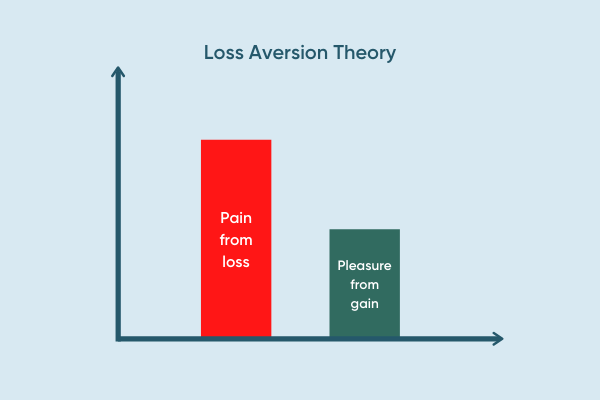
Understanding how we operate as people and as investors is one of the key starting points to building great investing habits. We all have different appetites for risk, abilities to regulate our emotions and goals that we’re moving towards. These differences make us who we are, and they also play into our ability to make sound investing decisions.
But what if we said we were actually more alike than you think when it comes to how we make our investment decisions?d-
Introducing loss aversion.
What is loss aversion?
Loss aversion is a behavioural bias whereby people tend to prefer avoiding losses more than acquiring potential gains.
It’s important to understand how loss aversion relates to investing, as it drives how people assess decisions under uncertainty. It affects our individual decision-making process and can influence how we decide to invest. Specifically, it can impact what we decide to invest in, how much we invest, when we buy and sell shares and more.
Loss aversion in practise
Let’s say if I were to flip a coin and it landed on Heads, I would need to give you $5. But if it were to land on Tails, you would need to give me $5. Would you take the deal?
Maybe not.
Ok let’s say if it landed on Heads, I would have to give you $10. And if it landed on Tails, you would only have to give me $5. Would you take the deal then?
Mathematically, this is has now become a good deal. This bet would have an expected value of $2.50.
(50% x $10) – (50% x $5) = $5 – $2.50 = $2.50.
Despite the now more attractive deal, many people still wouldn’t take the deal. This is thanks to Loss Aversion Theory. We naturally lean towards avoiding the losses more so than acquiring the potential gains.

Understanding loss aversion
It’s important to understand why we see potential losses before we see potential gains as it can have a large impact on the way we make investment decisions. Not only that, but it’ll help you understand more about yourself and your emotions when it comes to all decision making.
Avoid sunk cost fallacy
When we’ve invested our hard-earned cash into something, we can often find it difficult to cut our losses. Even when it’s evident that this is no longer beneficial. Loss aversion suggests we don’t want to “lose” the money, time, and effort we’ve already invested into something, so we stick with it. We’re emotionally attached. As a result, we hold onto investments for too long in the hopes it’ll recover the losses in the long-term. Not only can this result in monetary losses but you can also forgo other great opportunities.
A common occurrence of loss aversion is with property investments. Investors hold on to a property waiting for it to be profitable someday, but continue to pay interest on their loans until they eventually sell the property. This could have been avoided if they sold earlier.
Say goodbye to fear-based decision-making
When we’re fixated on avoiding our losses, we make decisions and act from a place of fear. This can in turn result in us making even bigger mistakes.
Take Lance Armstrong for example. He was so fixated on not losing the Tour De France (and winning as a result), he decided the pain of losing was worth any cost. This cost ended up being the very thing he was working towards: multiple Tour De France titles and his stellar reputation.
“Far more money has been lost by investors preparing for corrections or trying to anticipate corrections than has been lost in corrections themselves.”
– Peter Lynch
Combatting loss aversion tendencies
Whether you’re conscious of it or not, it’s likely you experience loss aversion in some shape or form. Here are a few tips to help you keep yourself in check:
1. Revert to your investment plan
Circle back and check in with your investing and exit plans before making an investment decision, whether that’s buying or selling. If it’s not in the plan, don’t do it. If it’s time to exit the markets and sell your shares, stick to the plan. And if you don’t have a plan yet, make one!
2. Take a long-term perspective
Remember, investing is a long-term play. By taking a long-term approach, you’re not focused on the daily, weekly or monthly ups and downs of the share markets, nor are you focused on the short-term impact of red or green numbers in your portfolio.
3. Automate your investing
An easy way to ensure loss aversion doesn’t influence your investing decisions and you’re sticking to your long-term plan is to put measures in place that drive you away from engaging with your investments every day. Lots of Kernel investors set up auto-investing so their investments are out of sight, out of mind. When your investments are top of mind, there’s a higher chance you’ll want to change something about them so it helps to reduce the temptation with the help of technology.
